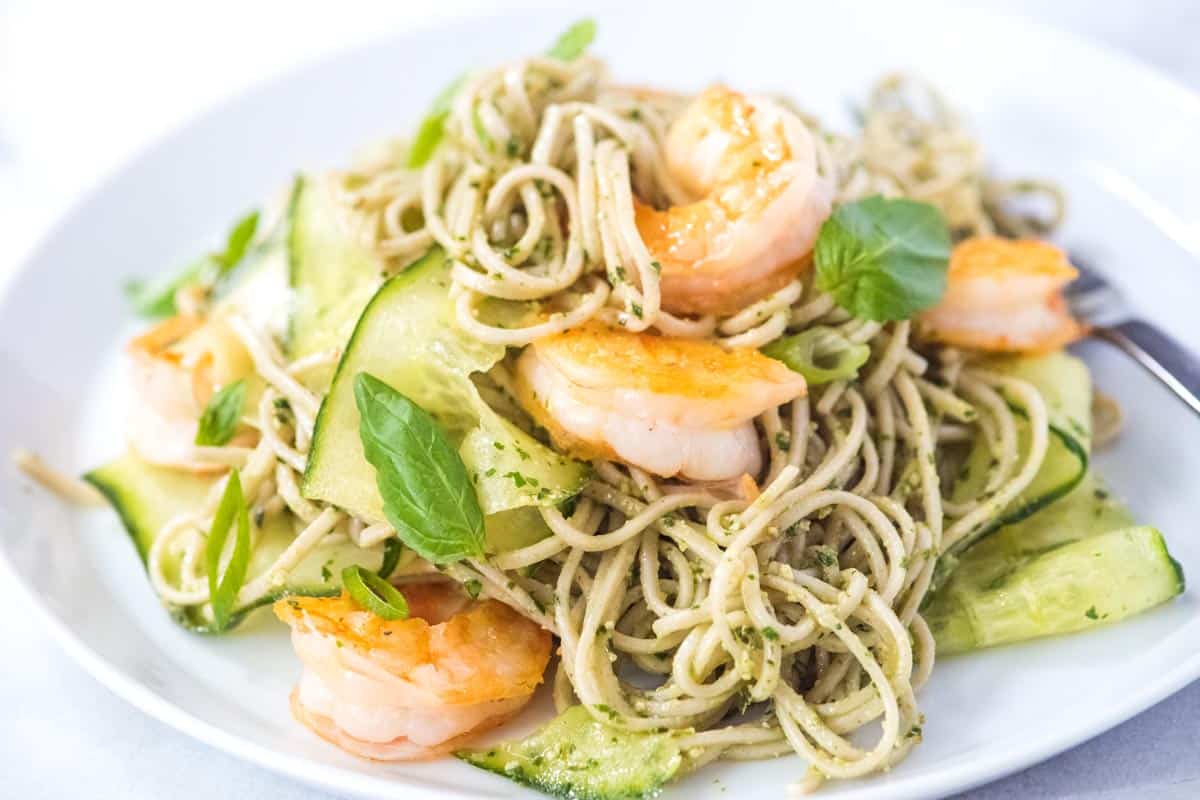
Pesto Soba Noodles with Shrimp
- PREP 15min
- COOK 10min
- TOTAL 25min
These pesto tossed soba noodles with shrimp come together fast. The noodles and shrimp only take about 5 minutes to cook. The pesto can be made in advance or you can swap the recipe below for a store-bought version. If you do make your own pesto, you will be done in under 15 minutes. Feel free to add your favorite vegetables to this — zucchini, bell pepper or edamame are all excellent. Shrimp is delicious in this, but you can easily swap them for chicken, tofu or more vegetables.
You Will Need
Soba Noodles
6 ounces soba noodles or noodles of choice
1 pound shrimp, peeled and deveined
1 tablespoon extra-virgin olive oil
Half of a lemon
4 to 6 tablespoons basil pesto, recipe below
Half of a seedless (English or hothouse) cucumber
1 scallion, ends and tops trimmed and thinly sliced
Salt and fresh ground black pepper
Handful torn or small basil leaves for serving
Homemade Pesto
2 cups fresh basil leaves
1 clove garlic
1/4 cup pine nuts or walnuts, lightly toasted
1/2 cup olive oil, plus more for storing
1/2 cup finely grated pecorino or parmesan cheese
Salt and fresh ground black pepper, to taste
Directions
Make Noodles
Bring a large pot of water to a boil. Add the soba noodles and cook until pasta is cooked, but not mushy. Check the package directions, but this usually takes 4 to 5 minutes. Drain noodles then immediately rinse under cold water until the noodles are no longer hot.
Meanwhile, heat the olive oil in a wide skillet over medium-high heat. Add the shrimp in one layer and cook, turning occasionally, until pink, firm, and cooked through; 6 to 8 minutes. Squeeze the juice from half a lemon over the cooked shrimp.
Use a vegetable peeler or mandoline slicer to shave the cucumber lengthwise into thin strips. Or simply chop into bite-size pieces.
Combine the noodles, shrimp, cucumber, and 4 tablespoons of the pesto. Toss well, adding more pesto as necessary. Serve with scallions and fresh basil scattered on top.
How to Make Pesto
Prepare a small bowl of ice water. Bring a small saucepan, filled halfway with salted water, to a boil. Submerge basil leaves in boiling water for 5 to 10 seconds, or until wilted. Then immediately plunge into ice water to stop cooking. Drain, squeeze to remove excess water then pat dry with a clean dish towel. This step helps to make the greenest pesto possible. By blanching the basil, it makes the leaves bright green. You can skip this step and just add the basil straight into the food processor.
Smash and peel the garlic clove then mince. Holding a chef’s knife at an angle, scrape the blade of the knife across the minced garlic. Gather it all together then scrape it against the board again until it becomes a very fine paste.
Add the garlic and the pine nuts in the bowl of a food processor. Pulse 2 to 3 times until everything is chopped small. Add basil.
With the processor running, slowly pour the olive oil into the bowl. Once all the olive oil has been added, check the consistency of the pesto — we like it to have some texture. If you prefer it smoother, pulse a few more times.
Transfer pesto to a bowl then stir in cheese and season to taste with salt and pepper. Use immediately or store for later.
Store Pesto in the Refrigerator: Add a thin layer of extra olive oil to the top (to prevent any air from getting to it), cover with a lid or plastic wrap and refrigerate up to 2 weeks.
How to Freeze Pesto: If freezing, leave out the cheese. Fill ice cube trays with pesto, freeze until hard. Then store frozen cubes in freezer-safe plastic bags. Freeze up to 1 month.
Adam and Joanne's Tips
- Gluten-free soba noodles: Not all soba noodles sold are 100% gluten-free. To make this gluten-free, double check the package to see if wheat has been added to the noodles.
- For more tips about making homemade pesto, here’s our article about making the greenest pesto with lots of photos to help you out.
- Nutrition facts: The nutrition facts provided below are estimates. We have used the USDA database to calculate approximate values.
If you make this recipe, snap a photo and hashtag it #inspiredtaste — We love to see your creations on Instagram and Facebook! Find us: @inspiredtaste